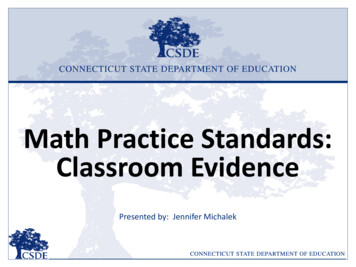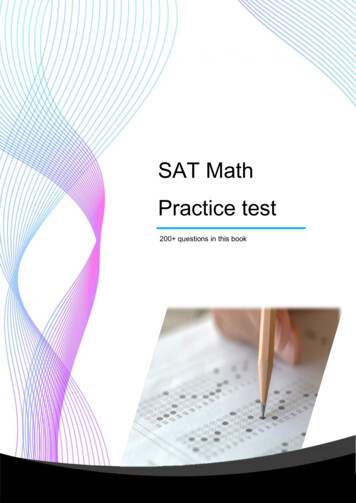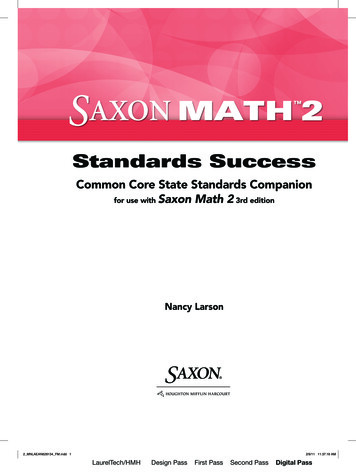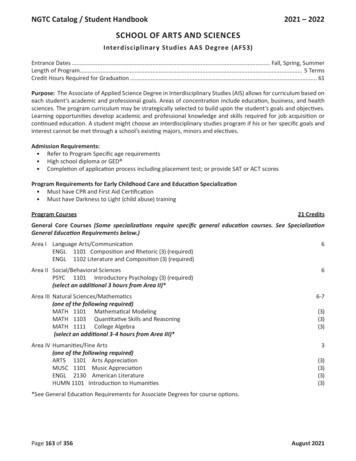
Transcription
CONNECTICUT STATE DEPARTMENT OF EDUCATIONMath Practice Standards:Classroom EvidencePresented by: Jennifer MichalekCONNECTICUT STATE DEPARTMENT OF EDUCATION
What’s in the CCS-Math? The Standards for Mathematical Content Define what students should understand andbe able to do K-8 Grade Level Domains High School Conceptual Categories The Standards for Mathematical Practice Describe HABITS OF MIND of a mathematicallyexpert student Recurring throughout the gradesCONNECTICUT STATE DEPARTMENT OF EDUCATION
Background of the MathPractice StandardsCONNECTICUT STATE DEPARTMENT OF EDUCATION
Draws from Two Sources Principals and Standards forSchool Mathematics Adding It UpCONNECTICUT STATE DEPARTMENT OF EDUCATION4
NCTM Principles and Standards forSchool Mathematics Problem Solving Reasoning and Proof Communication Representation ConnectionsCONNECTICUT STATE DEPARTMENT OF EDUCATION5
Process Standards Problem Solving - The process of applying a variety ofappropriate strategies based on information provided,referenced, recalled, or developed. Reasoning and Proof – Making and investigating mathematicalconjectures. Developing arguments and proofs. Communication – Organizing mathematical thinking coherentlyand clearly to peers, teachers and others. Using the language ofmath to express mathematical ideas precisely. Representation – Creating and using multiple representations toorganize, record and communicate mathematical ideas. Usingmodels and interpreting mathematical phenomena. Connections – Recognizing and using connections among mathideas as well as other subjects. Understanding how mathematicalideas interconnect and build on one ICUT STATE DEPARTMENT OF EDUCATION6
Adding It Up: Strands ofMathematical lFluencyCONNECTICUT STATE DEPARTMENT OF EDUCATION7
Strands of MathematicalProficiency Conceptual Understanding – comprehension of mathematicalconcepts, operations, and relations Procedural Fluency – skill in carrying out procedures flexibly,accurately, efficiently, and appropriately Strategic Competence – ability to formulate, represent, andsolve mathematical problems Adaptive Reasoning – capacity for logical thought, reflection,explanation, and justification Productive Disposition – habitual inclination to seemathematics as sensible, useful, and worthwhile, coupledwith a belief in diligence and one’s own efficacy.CONNECTICUT STATE DEPARTMENT OF EDUCATION8
CrosswalkNCTM Process Standards Problem Solving Reasoning and Proof Communication Representation ConnectionsActivity 1Strands of MathematicalProficiency Conceptual Understanding Procedural Fluency Strategic Competence Adaptive Reasoning Productive DispositionCONNECTICUT STATE DEPARTMENT OF EDUCATION
The Standards forMathematical Practice1. Make sense of problems and persevere in solving them.2. Reason abstractly and quantitatively.3. Construct viable arguments and critique the reasoning ofothers.4. Model with mathematics.5. Use appropriate tools strategically.6. Attend to precision.7. Look for and make use of structure.8. Look for and express regularity in repeated reasoning.CONNECTICUT STATE DEPARTMENT OF EDUCATION10
Problem solving and precisionGrouping the StandardsBill McCallum, 2011CONNECTICUT STATE DEPARTMENT OF EDUCATION
Understanding the MathPractice StandardsCONNECTICUT STATE DEPARTMENT OF EDUCATION
Standards for MathematicalPractice Dual NatureStandards for MathematicalPractice describe mathematicalcontent students need to learn.SP1. Make sense of problems“ students can explaincorrespondences betweenequations, verbal descriptions,tables, and graphs or drawdiagrams of important features andrelationships, graph data, andsearch for regularity or trends.”Standards for Mathematical Practicedescribe the nature of the learningexperiences, thinking processes, habitsof mind, and dispositions that studentsneed to develop a deep, flexible, andenduring understanding ofmathematics.SP1. Make sense of problems“ .they [students] analyze givens,constraints, relationships and goals. .they monitor and evaluate theirprogress and change course ifnecessary. . and they continually askthemselves “Does this make sense?”CONNECTICUT STATE 13DEPARTMENT OF EDUCATION
The Beginning of the PracticeStandardsActivity 2Take a moment to examine the first three words ofeach of the 8 mathematical practices.What do you notice?Mathematically Proficient Students CONNECTICUT STATE DEPARTMENT OF EDUCATION
Practice Standards ActionsActivity3What are the verbs that illustrate the student actions for yourassigned mathematical practice?Circle, highlight or underline them for each practice.Discuss with a partner:What jumps out at you?What few words summarize the actions needed for thepractice?What implications might each standard for mathematicalpractice have on classroom instruction?CONNECTICUT STATE DEPARTMENT OF EDUCATION
The Standards forMathematical PracticeSMP1: Explain and make conjectures SMP2: Make sense of SMP3: Understand and use SMP4: Apply and interpret SMP5: Consider and detect SMP6: Communicate precisely to others SMP7: Discern and recognize SMP8: Notice and pay attention to CONNECTICUT STATE DEPARTMENT OF EDUCATION
An Illustration of the PracticesActivity 4CONNECTICUT STATE DEPARTMENT OF EDUCATION
Deep Dive IntoImplementationCONNECTICUT STATE DEPARTMENT OF EDUCATION
Successfully Implementing theStandards .Requires: Teacher knowledge of mathematics language andcontent. Teacher knowledge of how to promote studentinvolvement in mathematical practices. Shifting students’ focus from “answer getting” tosolving problems. Establishing the classroom environment as acommunity of learners.CONNECTICUT STATE DEPARTMENT OF EDUCATION
Implementing the PracticesResource Content is the vehicle for engaging in the Standards forMathematical Practice. Practices should be embedded in classroom instruction,discussions, activities and assessment and connected tocontent in meaningful ways. The Standards for Mathematical Practice are not a checklist. Practices work together and a single student behavior couldbe thought of as exhibiting multiple practices at once. The Standards for Mathematical Practice look differentacross the grades as students grow in mathematicalmaturity. There is a progression of the math practice standards.CONNECTICUT STATE DEPARTMENT OF EDUCATION
LessonsTasks Engage the students inthe math practicestandards Contain elements thatspeak to specific mathpracticesTeacher Actions Develops the mathpractice standardswithin the studentsCONNECTICUT STATE DEPARTMENT OF EDUCATION
QuestioningResource Effective questioning can support the student’sdevelopment of the mathematical practices Effective questioning invites students to explaintheir thinking, make new connections, describetheir process, or critique other ideas Questioning should be aligned to themathematical practiceCONNECTICUT STATE DEPARTMENT OF EDUCATION
What do classrooms looklike if engaged in themath practices?CONNECTICUT STATE DEPARTMENT OF EDUCATION
Task Element MP1MP 1: Make sense of problems and persevere in solving them Requires students to engage with conceptual ideas that underlie theprocedures to complete the task and develop understanding. Requires cognitive effort - while procedures may be followed, theapproach or pathway is not explicitly suggested by the task, or taskinstructions and multiple entry points are available. Encourages multiple representations, such as visual diagrams,manipulatives, symbols, and problem situations. Making connectionsamong multiple representations to develop meaning. Requires students to access relevant knowledge and experiences andmake appropriate use of them in working through the tical-Practices-Updated-2016.pdfCONNECTICUT STATE DEPARTMENT OF EDUCATION
Teacher Actions MP1MP 1: Make sense of problems and persevere in solving them Allows students time to initiate a plan; uses question prompts asneeded to assist students in developing a pathway. Continually asks students if their plans and solutions make sense. Questions students to see connections to previous solutionattempts and/or tasks to make sense of current problem. Consistently asks to defend and justify their solution by comparingsolution atical-Practices-Updated-2016.pdfCONNECTICUT STATE DEPARTMENT OF EDUCATION
In Practice: MP1Activity 5CONNECTICUT STATE DEPARTMENT OF EDUCATION
Task Element MP2MP 2: Reason Abstractly and quanitatively Includes questions that require students to attend to the meaningof quantities and their relationships, not just how to computethem. Consistently expects students to convert situations into symbols inorder to solve the problem; and then requires students to explainthe solution within a meaningful situation. Contains relevant, realistic ematical-Practices-Updated-2016.pdfCONNECTICUT STATE DEPARTMENT OF EDUCATION
Teacher Actions MP2MP 2: Reason Abstractly and quantitatively Asks students to explain the meaning of the symbols in theproblem and in their solution. Expects students to give meaning to all quantities in the task. Questions students so that understanding of the relationshipsbetween the quantities and/or the symbols in the problem and thesolution are fully athematical-Practices-Updated-2016.pdfCONNECTICUT STATE DEPARTMENT OF EDUCATION
In Practice: MP2CONNECTICUT STATE DEPARTMENT OF EDUCATION
Task Element MP3MP 3: Construct viable arguments and critique the reasoning ofothers Is structured to bring out multiple representations, approaches, or erroranalysis. Embeds discussion and communication of reasoning and justificationwith others. Requires students to provide evidence to explain their thinking beyondmerely using computational skills to find a solution. Expects students to give feedback and ask questions of others’ thematical-Practices-Updated-2016.pdfCONNECTICUT STATE DEPARTMENT OF EDUCATION
Task 1Joel and Marisa are running for president at their middle school(grades 6-8). After the votes are in, Joel and Marisa are eachconvinced that they have won the election. Joel argues that he has won a larger percentage of the overallvote than Marisa so he should be the new president. Marisa argues that she has won a larger percentage than Joel ofthe 6th grade vote and the 7th grade vote. Since the majority ofthe grades voted for her, she should be the new president.Is it possible that both Joel and Marisa are making accurateclaims? Explain.CONNECTICUT STATE DEPARTMENT OF EDUCATION
Teacher Actions MP3MP 3: Construct viable arguments and critique the reasoning of others Encourages students to use proven mathematical understandings, (definitions,properties, conventions, theorems etc.), to support their reasoning. Questions students so they can tell the difference between assumptions andlogical conjectures. Asks questions that require students to justify their solution and their solutionpathway. Prompts students to respectfully evaluate peer arguments when solutions areshared. Asks students to compare and contrast various solution methods Creates various instructional opportunities for students to engage inmathematical discussions (whole group, small group, partners, tical-Practices-Updated-2016.pdfCONNECTICUT STATE DEPARTMENT OF EDUCATION
In Practice: MP3CONNECTICUT STATE DEPARTMENT OF EDUCATION
Task Element MP4MP 4: Model with mathematics Is structured so that students represent the problem situation andtheir solution symbolically, graphically, and/or pictorially (mayinclude technological tools) appropriate to the context of theproblem. Invites students to create a context (real-world situation) thatexplains numerical/symbolic representations. Asks students to take complex mathematics and make it simpler bycreating a model that will represent the relationship between UT STATE DEPARTMENT OF EDUCATION
Teacher Actions MP4MP 4: Model with mathematics Demonstrates and provides students experiences with the use ofvarious mathematical models. Questions students to justify their choice of model and thethinking behind the model. Asks students about the appropriateness of the model chosen. Assists students in seeing and making connections among matical-Practices-Updated-2016.pdfCONNECTICUT STATE DEPARTMENT OF EDUCATION
In Practice: MP4CONNECTICUT STATE DEPARTMENT OF EDUCATION
Task Element MP5MP 5: Use appropriate tools strategically Lends itself to multiple learning tools. (Tools may include; concretemodels, measurement tools, graphs, diagrams, spreadsheets,statistical software, etc.) Requires students to determine and use appropriate tools to solveproblems. Asks students to estimate in a variety of situations: a task when there is no need to have an exact answer a task when there is not enough information to get an exact answer a task to check if the answer from a calculation is thematical-Practices-Updated-2016.pdfCONNECTICUT STATE DEPARTMENT OF EDUCATION
Teacher Actions MP5MP 5: Use appropriate tools strategically Demonstrates and provides students experiences with the use of variousmath tools. A variety of tools are within the environment and readilyavailable. Questions students as to why they chose the tools they used to solve theproblem. Consistently models how and when to estimate effectively, and requiresstudents to use estimation strategies in a variety of situations. Asks student to explain their mathematical thinking with the chosen tool. Asks students to explore other options when some tools are T STATE DEPARTMENT OF EDUCATION
In Practice: MP5CONNECTICUT STATE DEPARTMENT OF EDUCATION
Task Element MP6MP 6: Attend to precision Requires students to use precise vocabulary (in written and verbalresponses) when communicating mathematical ideas. Expects students to use symbols appropriately. Embeds expectations of how precise the solution needs to be(some may more appropriately be athematical-Practices-Updated-2016.pdfCONNECTICUT STATE DEPARTMENT OF EDUCATION
Teacher Actions MP6MP 6: Attend to precision Consistently uses and models correct content terminology. Expects students to use precise mathematical vocabulary duringmathematical conversations. Questions students to identify symbols, quantities and units in aclear matical-Practices-Updated-2016.pdfCONNECTICUT STATE DEPARTMENT OF EDUCATION
In Practice: MP6CONNECTICUT STATE DEPARTMENT OF EDUCATION
Task Element MP7MP 7: Look for and make use of structure. Requires students to look for the structure within mathematics in order to solvethe problem. (i.e. – decomposing numbers by place value; working withproperties; etc.) Asks students to take a complex idea and then identify and use the componentparts to solve problems. i.e. Building on the structure of equal sharing, studentsconnect the understanding to the traditional division algorithm. When “unitsize” cannot be equally distributed, it is necessary to break down into a smaller“unit size”such as with long division Expects students to recognize and identify structures from previousexperience(s) and apply this understanding in a new situation. i.e. 7 x 8 (7 x 5) (7 x 3) OR 7 x 8 (7 x 4) (7 x 4) new situations could be, distributiveproperty, area of composite figures, multiplication fact strategies. l-Practices-Updated-2016.pdfCONNECTICUT STATE DEPARTMENT OF EDUCATION
Teacher Actions MP7MP 7: Look for and make use of structure. Encourages students to look for something they recognize andhave students apply the information in identifying solution paths(i.e. composing/decomposing numbers and geometric figures,identifying properties, operations, etc.) Expects students to explain the overall structure of the problemand the big math idea used to solve the ematical-Practices-Updated-2016.pdfCONNECTICUT STATE DEPARTMENT OF EDUCATION
In Practice: MP7CONNECTICUT STATE DEPARTMENT OF EDUCATION
Task Element MP8MP 8: Look for and express regularity in repeated reasoning. Present several opportunities to reveal patterns or repetition inthinking, so students can make a generalization or rule. Requires students to see patterns or relationships in order todevelop a mathematical rule. Expects students to discover the underlying structure of theproblem and come to a generalization. Connects to a previous task to extend learning of a NECTICUT STATE DEPARTMENT OF EDUCATION
Task 2Track your thinking so you can explain your thinking to someone else. In allcases, try to NOT calculate; rather REASON about the two quantities.1. Which quantity is greater?i.694 – 345 233233 – 345 694ii. 790 135 232795 133 230iii. 13 – 9 12 – 110iv.163 6v. 3 x 7 - 2(x 7)vi. 4 (x 3)2vii. 5% of 7 billion1x 7π7% of 5 billionCONNECTICUT STATE DEPARTMENT OF EDUCATION
Teacher Actions MP8MP 8: Look for and express regularity in repeated reasoning. Asks what math relationships or patterns can be used to assist inmaking sense of the problem. Asks for predictions about solutions at midpoints throughout thesolution process. Questions students to assist them in creating generalizations basedon repetition in thinking and athematical-Practices-Updated-2016.pdfCONNECTICUT STATE DEPARTMENT OF EDUCATION
In Practice: MP8CONNECTICUT STATE DEPARTMENT OF EDUCATION
Summary of EvidenceActivity 6 Students are doing the work, not merely mimickingthe work the teacher demonstrated. Student work products include more than justcalculations. Claims and justifications Models and representations Classifications Students ask questions that they’re not sure anybodyknows the answer to.CONNECTICUT STATE DEPARTMENT OF EDUCATION
Assessing the MathPractice StandardsCONNECTICUT STATE DEPARTMENT OF EDUCATION
The Link to AssessmentActivity 7 For Claims 2, 3, and 4 on the SmarterBalanced Assessment, the assessmenttargets are drawn from the CT CoreStandards for Mathematical Practice. The assessment targets for Claims 2, 3, and4 are the same across all tested grades.CONNECTICUT STATE DEPARTMENT OF EDUCATION
Grade 4 Sample Assessment ItemPablo solved a multiplication problem using two differentmethods. He made a mistake in either Method W or Method Z.Identify the method where Pablo made a mistake and explain whathe should do to correct it. Type your answer in the box below.CONNECTICUT STATE DEPARTMENT OF EDUCATION
Finding EvidenceCONNECTICUT STATE DEPARTMENT OF EDUCATION
Core Action 3ResourceProvide all students with opportunities to exhibitmathematical practices while engaging with the contentof the lessonRATING:4 – Teacher provides many opportunities, and most students take them3 – Teacher provides many opportunities, and some students take them orTeacher provides some opportunities and most students take them2 – Teacher provides some opportunities, and some students take them1 – Teacher provides few or no opportunities orfew or very few students take the opportunities providedCONNECTICUT STATE DEPARTMENT OF EDUCATION
Core Action 3 Teacher IndicatorsProvide all students with opportunities to exhibit mathematical practiceswhile engaging with the content of the lesson.A. The teacher provides opportunities for all students to work with andpractice course-level problems and exercises.B. The teacher cultivates reasoning and problem solving by allowingstudents to productively struggle.C. The teacher poses questions and problems that prompt students toexplain their thinking about the content of the lesson.D. The teacher creates the conditions for student conversations wherestudents are encouraged to talk about each other’s thinking.E. The teacher connects and develops students’ informal language andmathematical ideas to precise mathematical language and ideas.CONNECTICUT STATE DEPARTMENT OF EDUCATION
Core Action 3 Student IndicatorsProvide all students with opportunities to exhibit mathematicalpractices while engaging with the content of the lesson.A. Students work with and practice course-level problems andexercises.B. Students persevere in solving problems in the face of difficulty.C. Students share their thinking about the content of the lessonbeyond just stating answers.D. Students talk and ask questions about each other’s thinking, inorder to clarify or improve their own mathematical understanding.E. Students use increasingly precise mathematical language and ideas.CONNECTICUT STATE DEPARTMENT OF EDUCATION
Activity 8CONNECTICUT STATE DEPARTMENT OF EDUCATION
What instructional decisions did the teachermake that seemed to support thedevelopment of Standards forMathematical Practice for students?What did you hear or see in a mathematicsclassroom that is working to build theStandards for Mathematical Practice?CONNECTICUT STATE DEPARTMENT OF EDUCATION
Standards for MathematicalPracticeThe eight standards formathematical practice placean emphasis on studentsdoing mathematics anddemonstrating learning.Equitable achievement will beginwith an understanding of how the selection of tasks, assessment of tasks, and student learning environmentcan support or undermine equityin our schools.CONNECTICUT STATE 60DEPARTMENT OF EDUCATION
Final ThoughtHow do I know that all students have opportunities toexhibit mathematical practices while engaging with thecontent of the lesson? Are questions and problems posed that prompt students to share theirdeveloping thinking? What opportunities do students have to work with and practice gradelevel problems? What strategies are used to encourage collaboration among students? Do students explain their thinking? Do students talk about each other’s thinking? Do students persist in solving challenging problems? Does the teacher connect student’s informal language to precisemathematical language?CONNECTICUT STATE DEPARTMENT OF EDUCATION
CONNECTICUT STATE DEPARTMENT OF EDUCATION
Thank YouJennifer MichalekMath Education ECTICUT STATE DEPARTMENT OF EDUCATION
(grades 6-8). After the votes are in, Joel and Marisa are each convinced that they have won the election. Joel argues that he has won a larger percentage of the overall vote than Marisa so he should be the new president. Marisa argues that she has won a larger percentag











